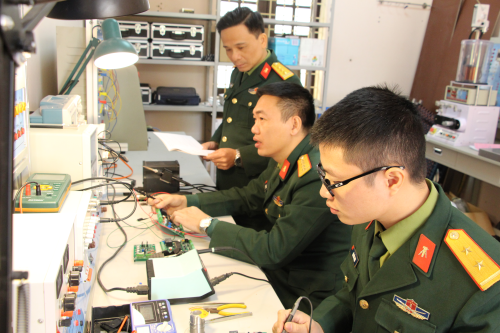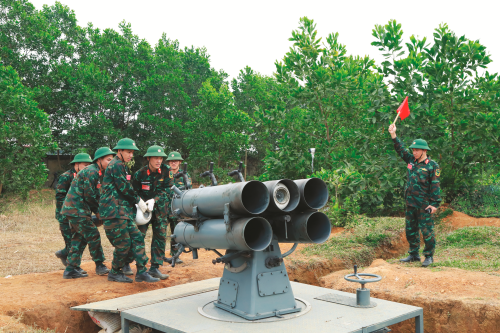Research and development of new, modern products, research and application of advanced technology as well as gradual mastery of core technology to design and develop weapons and technical equipment in particular, is a vital objective, task, and an urgent requirement for establishing and developing a modern, dual-use, resilient, self-reliant defence industry in support of building a modern military in the context of the Fourth Industrial Revolution. This task emphasises combination of many factors, especially high-quality human resources, a robust, comprehensive industry, preferential policies, infrastructure used for research and development, technology transfer both at home and abroad. Over the past few years, the Institute of Technology (IoT), General Department of Defence Industry (GDDI) has sticked to its missions and the aforementioned orientation and adopted synchronous measures to enhance scientific studies, focusing on research and development of new, modern products.
To fulfil its goals, first, the IoT shifts away from prototype-based production to research and development of new products. Having grasped Resolution No. 209-NQ/DU, dated 8 July 2019 of the GDDI Party Committee on leading increased research and development of novel weapons and technical equipment to contribute to military modernisation and Resolution No. 814-NQ/DU, dated 7 April 2023 of the GDDI Party Committee on the leadership of scientific, technological work throughout 2030 and beyond, the IoT brings into play the role of its Council of Science and Technology in embracing development trends in technical equipment in the world and the Ministry of National Defence’s orientation towards weapons and equipment of the military as well as programmes and projects in support of defence production to map out mid- and long-term plans for science and technology studies. Of note, the research and development of new products is the key objective. It also promotes democracy and collective wisdom in proposal of ideas and implementation solutions. Over the past few years, by sticking to the viewpoint of “no basic studies, no technologies,” the IoT has gradually innovated its way of thinking and doing with a focus on balancing basic studies with applied ones. This aims to develop new products in both directions, i.e., application of new technologies to improvement and upgrade of available weapons and equipment and research and development of new products. To do so, the IoT seeks to establish and leverage the role of research groups and expert teams as well as form disciplinary and interdisciplinary strong research groups. It also improves management and budget mechanisms in the direction of delegating power and allocating tasks and research projects to affiliated bodies and units, collectives, and individuals, especially the project managers. This aims to enhance self-reliance and flexibility in formulating plans, proposing new projects, conducting experiment, and evaluating research projects. Moreover, the IoT promotes linakage with science research units in the military and beyond to implement research projects.
 |
| Research and development of new products |
Given its breakthroughs in management, thinking, and ways to conduct scientific research, the IoT has encouraged and brought into play the dynamics and creativeness of the corps of cadres and employees in grasping reality and demands of departments and units to propose new research projects. The IoT has successfully carried out 84 Institute- and State-level projects on research and development of new weapons and technical equipment since 2015. More importantly, the IoT has basically mastered the design and development of most ammunition for army and air defence weapons, some naval ammunition, artillery ammunition, artillery barrels, rocket launchers, some types of special alloy and materials for manufacturing missile components, warheads, and shell casings as well as paint used for aircraft and submarines. The IoT has initially researched, developed, and mastered part of technologies to produce high-tech weapons and mobile weapons as well as integrate systems such as low-altitude air defence missiles, fighting robots, reconnaissance robots, infantry fighting vehicles, howitzers, short-range fire-control radars, etc., contributing to increased proactiveness of the domestic defence industry, reduction of imports, and provision of new weapons and equipment for the military.
The IoT, which is the leading multidisciplinary research centre of the GDDI, is assigned to lead and participate in key State- and MND-level projects to research and develop new products and integrate many modern, complex technologies. To do so, the IoT attaches importance to establishment of science and technology potential in a synchronous, in-depth direction and regards the building of human resources as the key factor. The goal is to build a corps of cadres with political steadfastness, proper structure, synchronicity in terms of specialties, professional standardisation, knowledge, skills, and passions for science research and career. Over the past few years, together with doing political, ideological work well, the IoT attaches importance to source generation, planning, training, and use of cadres with a focus on building and developing young science cadres, leading technological experts, and chief engineers. During the training process, the IoT combines on-site training with in-depth trining at home and abroad. It also pays attention to training of cadres’ practical competence through sending them to units and factories to directly participate in production, thus encouraging cadres to improve their knowledge and skills. Additionally, the IoT always gives priority to policy work, which aims to make cadres and employees dedicated to their jobs. Currently, 90 percent of cadres have graduated university, of which 70 percent have postgraduate degrees and 18 percent are recognised as senior researchers and engineers, thereby initially establishing a corps of leading experts in all fields.
 |
| Testing of new product |
In addition to development of human resources, the IoT proactively proposes and promotes investment in upgrading infrastructure in support of research in a modern, synchronous, in-depth direction. Priorities are given to equipment for inspecting, measuring, and experimenting with new weapons and equipment as well as supporting basic studies, creating the technical foundation for improving the IoT’s competence for research, experiment, and development of products. Accordingly, the IoT has formulated and requested the higher echelons to approve projects on upgrading and building infrastructure used for researching and testing new weapons and equipment according to concrete roadmaps. In the 2019 – 2023 period, it has completed one laboratory project, four tasks of maintaining and repairing the MND-level laboratory at a small scale, and so on. Furthermore, the IoT steps up the movement for leveraging technical innovation initiatives to promote science studies. The tenological infrastruction in support of the IoT’s research has been upgraded and modernised to directly enhance design and development of new products so far. The IoT intensifies implementation of the “Project on establishing and developing the Institute of Technology by 2025 with vision to 2035.” Accordingly, it formulates and request relevant agencies to approve investment projects in facilities and specialised laboratories such as Increased Competence of the Institute of Technology, Specialised Material Laboratory, Rubber Laboratory, Laboratory for Simulating Guided Weapons and High-Tech Weapons, etc., to meet short- and long-term demands. In the near term, the IoT enhances its competence in research, design, reception, and mastery of technologies to design some modern weapons and equipment as well as technologies to integrate weapons into some combat vehicles, thereby increasing mobility of weapons and equipment.
To narrow the technological gap in designing modern weapons and equipment with advanced countries in the region and the world, the IoT enhances cooperation in science research and technology transfer, thus taking adavantage of studies at home and abroad and partners’ technologies to create overall power for task execution. Accordingly, in addition to participation in reception and transfer of technology from foreign partners according to cooperation programmes of the State and MND, the IoT steps up holding science workshops aimed at promoting exchange of experience with science research units at home and abroad. Besides, it actively cooperates with research centres and factories in sharing of technologies and exploiting laboratories, simulation technology, and modern, specialised research equipment to execute projects. In recent years, the IoT has cooperated with Russian experts, the Viet Nam Academy of Science and Technology, the National Centre for Technological Progress of the Ministry of Science and Technology, the Academy of Military Science and Technology of the General Staff, the Institute of Technology of the Ministry of Industry and Trade, the Military Technical Academy, and other institutes and factories of the GDDI in successfully implementing many major projects. Through such cooperation, the IoT’s corps of cadres can get to know and master new technologies such as new materials, simulation, FPGA-based imgage processing and digital signal processing, digital measurement and control, and so forth. These are the vital bases for the IoT to apply to research and development of new products.
On leveraging its outcomes, in the time to come, the IoT will continue to review and supplement its orientation for scientific and technological research in the 2025 – 2030 period and beyond; proactively propose research projects in line with technical support orientation, equipment support orientation, and building of a modern military and a modern, dual-use, resilient, self-reliant defence industry. Moreover, it actively proposes solutions for the GDDI to improve regulations, policies, and mechanisms for cooperation with foreign countries in carrying out programmes about research linkage, sharing of information, acquisition of equipment, and so on. This helps the IoT to take advantage of advancement of science and technology in the world to quickly master core, foundational technologies to manufacture modern, advanced weapons and equipment, meeting requirements of safeguarding the Fatherland in the new situation.
Senior Colonel, Doctor PHAM TUAN HAI, Director General